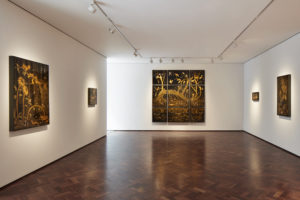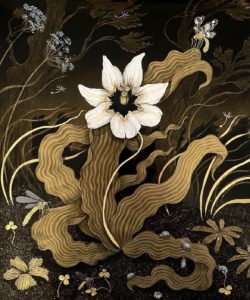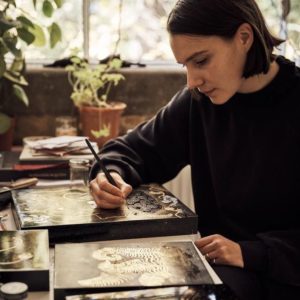
31 July – 1 September 2023
This exhibition will mark Tuesday Riddell’s third solo show at our Cork Street Gallery following the celebrated success of her previous two exhibitions in 2019 and 2021. Riddell was part of Messums Emerging Talent programme and is one of a number of artists represented by the Gallery whose practice is underpinned by extraordinary craftsmanship in the execution of their work.
Riddell works with japanning, a technique originally developed in the 17th century as an imitation of Asian lacquer work and very rarely used by contemporary artists today placing her work as unique in the field. The process of japanning is an extraordinarily laborious process which requires dedication and exceptional craftsmanship. Each panel of Riddell’s work contains between 25 to 30 layers of lacquer which has to be sanded between layers requiring long hours which, for her, become a form of meditation. She discovered the practice as the Painter Stainer’s Decorative Surface fellow at City & Guilds Art School by which time it was only practiced in conservation. Through this centuries old practice, she has found a new visual language, breathing new life into an almost lost craft.

The imagery in Riddell’s work takes us down to the forest floor and a glorious insight into the world that captures her imagination, that ethereal nocturne where all cycles of life and death carry on with rarely a watchful eye. The mysterious nature of these scenes, coupled with Riddell’s mastery of her technique, gives the work its exceptional quality. There is a luxury and richness to her surface: the depth of the black sharpens the contrast and the glow of the gold leaf making each piece look like a polished gemstone. Riddell describes: ‘My works intend to zoom into the insect level world like a magnifying glass, mirroring our own society, with so much harmony and beauty to be witnessed, as well as addressing issues about our environment, our role in it and even the philosophical dilemmas of having to face death and suffering. Art has often depicted the environment and time – my work addresses issues regarding the deterioration of flora and fauna reflective of our own current environmental crisis.’
The central piece in this exhibition was inspired by the artist’s visit to Beatrix Potter’s farm, Hill Top in the Lake District and a walk in the surrounding countryside. She recalls the impact of this visit:
‘It was a special experience for me because she is someone I have loved since I was a child. She was my first introduction to paintings that captured the environment and essence of an environment around her, but also the darkness of nature and the world.
Her stories really give you a sense of each of the places in her world and that’s what made me want to explore more the places I find a connection with. I have two places in London so most of the works are based on the stream and a willow I visit. The tree in the polyptych ‘The Night Tree’ (pictured top) is from a walk in the lake district where we stumbled across a tree that looked like it had fallen over, forming into a bridge shape, but it was still alive with branches growing upwards. The tree was so majestic and there were big red toadstools growing underneath it. I remember getting this feeling, like if you crawled under the arch, you would be transported to another realm. I love places like that. Places and things that remind you of dark fairy tales and folklore this place reminded me of a childhood story about fairy rings. I used to be told stories and read about things like that as a child, about people stepping into a ring of mushrooms and falling into another realm where they were left dancing around the ring in the fairy realm, until they withered away unable to survive outside of their own
world.’ Tuesday Riddell
In Anna Souter’s essay which accompany the exhibition, she discusses the connections between the work of Beatrix Potter and Riddell:
‘For artist Tuesday Riddell, Beatrix Potter’s small worlds represent a radical continuity between the magical and the real, where close observation of landscapes and ecosystems runs smoothly into a profound re-enchantment with the more-than human.
For Riddell, as for Potter, gaining an intimate knowledge of another being does not strip it of its personhood or its animacy, but rather enhances these qualities and offers a doorway into an imaginative empathy and sense of wonder.
Much of Riddell’s work is closely inspired by the illustrations of animal worlds she encountered in the books of her childhood, with a particular emphasis on the work of Beatrix Potter. Riddell’s images explore the interconnected lives of fungi, insects, birds, and mammals, often in the context of the forest floor or the banks of a body of water. Many of her shimmering, multi-layered images are set in the mysterious hours of darkness and twilight, suggesting a realm of imagined animal encounters, where secret gatherings take place in the absence of human watchers. Like Potter, Riddell creates spaces and relationships which are both fantastical and natural.’
Anna Souter, extract from Small Worlds: On Beatrix Potter and Tuesday Riddell.
